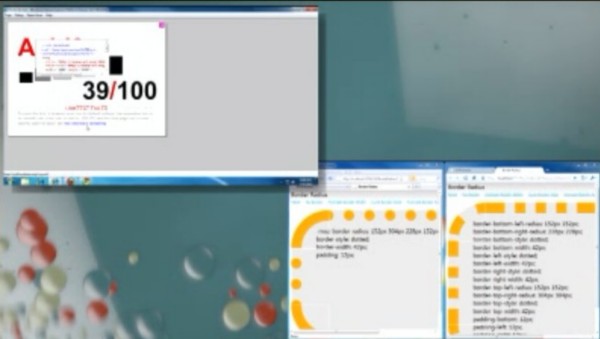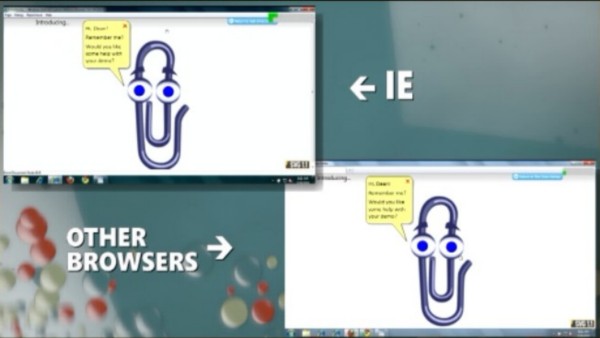By Scott M. Fulton, III, Betanews
Download Microsoft Internet Explorer 9 Platform Preview via Fileforum now.
[Today's delay in Betanews bringing you Internet Explorer 9 news was brought to you as a public service by the Cable Modem: Your Best Friend When It's Crunch Time. Remember, where there's smoke, there's a Comcast cable modem. Smell one today.]
It is perhaps the unlikeliest scenario any technologist could imagine as recently as two years ago: Microsoft evangelizing developers to embrace Web standards by helping it to build its Web browser. Although one of the first browsers to be distributed for free, Internet Explorer has never been open source. Historically, it's always been ready when it's ready; its value proposition has been to the consumer who prefers convenience over adaptability; and when the fact that it was dirt slow was pointed out, the response typically was, the consumer isn't going to care.
Today, the value proposition started to take shape for IE9, the browser that in an earlier era didn't need a value proposition. Microsoft's strategy, which premiered today at MIX 10, was to seize control of tomorrow's key talking point, HTML 5 compliance and compatibility -- to make HTML 5 identifiable with Internet Explorer. In fact, IE General Manager Dean Hachamovitch's greeting sentence to MIX 10 attendees this morning wasn't without the term "HTML 5."

"When we started looking deeply at HTML 5, we saw that it enabled a whole new class of applications," was Hachamovitch's second sentence. "These applications will stress the browser runtime and hardware, as today's sites just don't. We quickly realized that doing HTML 5 right -- our intent -- was more about designing around what HTML 5 applications will need, rather than a particular set of features. Done right, HTML 5 applications will feel more like real apps than Web pages, and our approach to HTML 5 is to make standard Web patterns that developers already know and use, just run faster and better by taking advantage of PC hardware through Windows."
Developers have always known that Microsoft has always had the capability to leverage its mastery of Windows APIs to build smoother applications. But as other Microsoft applications have weaned themselves off of the old Win32 dependencies, such as rendering using the old GDI and GDI+ libraries, Internet Explorer has fallen further and further behind. In fact, you could make the case that Silverlight gives Web developers opportunities to use the modern rendering libraries that IE should be using now natively.
Soliciting general developers' help in improving IE (some will say for the first time), Microsoft today began distributing the bare-bones chassis of the IE9 Web browser -- no frills, no features, not even bookmarks. Just a rendering engine in a window. With Google Chrome, Apple Safari, and now even Opera having made effective cases for the Web being "the platform," Microsoft desperately needs to resume defining the platform before someone else ends up defining it instead.
But one element of Microsoft's IE message remains the same even today: Those areas where the competitors say they have the advantage, may not be all that important to end users. Case in point: just-in-time compilation, the factor that has catapulted Mozilla Firefox and WebKit-based browsers such as Safari and Chrome into today's speed race.

For example, Hachamovitch did cite the IE9 chassis' speed improvement on the widely accepted SunSpider performance test, created by the originators of the open source WebKit engine. On Microsoft's chart, Opera is the fastest performer on the SunSpider, followed by a Chrome 5 dev build, a Chrome 4 stable build, and the latest Safari 4.0.5, released late last week by Apple (apologies for the fuzzy screenshot of Microsoft's chart). So yes, IE9 comes in fifth, rather than dead last. But the difference isn't that much of a difference, he said:
"It's interesting to note that the gap between IE9 and some of the other browsers to its right is about an eye-blink -- it's about 300 ms. And it took 70 seconds to identify that 300 ms difference."
When it comes to HTML 5, Microsoft wants to be perceived now as leading that standard. But with respect to standards at large, the company's position remains unchanged from last year: As long as Web standards are up in the air, compliance is a foggy term anyway. Today, Hachamovitch implied that if the goal of standards bodies were the same as Microsoft's goal of one language, the fog would be lifted:
"Developers want to use the same HTML, the same script, and the same markup across browsers. That's the goal of standards and interoperability. No need for different code paths for different browsers. That's a key goal for HTML 5. We love HTML 5 so much, we want it to actually work. In IE9, it will. We want the same HTML, the same script, the same markup to just work across browsers. So in IE9, we'll do for the rest of the Web platform what we did for CSS 2.1 in IE8. Now, at the same time, we want to be responsible about the standards that are still emerging, the standards that are in committee, and the standards that are partially implemented, often in different ways across browsers. So to make decisions on this front, we started from data."

As an Acid3 test runs in the background (it's not done yet), Dean Hachamovitch demonstrates how 'standards' support varies between even Firefox and Chrome (lower right) for the same markup.
The IE9 team leader went on to describe an internal tool that measured the script activity on 7,000 active Web sites. The telemetry that it received showed, for instance, that the #1 method in use was indexOf(), on 94% of sites measured. Number 17 on the list, used by 65% of sites, was addEventListener, a method that's key to W3C's advanced event registration model, but not yet supported in IE8.
"Because we started from data, what developers like you really use was our starting point for what to support." As a result, the IE9 chassis passed 578 out of 578 in the CSS3.info selectors test, putting it now on a par with Firefox. That's important, Hachamovitch noted, because developers want that one language -- one CSS, one HTML -- to work with for all browsers across the board.
 Meanwhile, the IE9 preview posts a 55% score on the Acid3 standards compliance test -- up from 20% for IE8, and 12% for IE7. The latest stable Firefox, by comparison, scores 94% on this test; and Safari, Chrome, and Opera all score 100%. Could the CSS3.info test be fair, and the Acid3 test unfair?
Meanwhile, the IE9 preview posts a 55% score on the Acid3 standards compliance test -- up from 20% for IE8, and 12% for IE7. The latest stable Firefox, by comparison, scores 94% on this test; and Safari, Chrome, and Opera all score 100%. Could the CSS3.info test be fair, and the Acid3 test unfair?
"Some people use Acid3 as shorthand for standards support. Acid3 is kind of interesting, it exercises about a hundred details of a dozen different technologies. Some of them are under construction, others less so," Hachamovitch said. He added a promise that Acid3 scores will continue to improve "as we make more of the markup that developers actually use, work."
Next: Offloading processing to the background and to the GPU... Offloading processing to the background and to the GPU
The architectural development that helped Firefox and others vault from banana-like bars such as those on the left of Microsoft's SunSpider chart, to peanut-like bars like those on the right, was the implementation of just-in-time compilation (JIT) -- a concept first implemented in Java and .NET, re-engineered for JavaScript. Today, Hachamovitch's tactic was to characterize JIT compilers as "JIT-ters," complete with the wimpy sound and unstable connotations, similar to how AMD characterized Intel's introduction of "hyperthreading" five years ago.
"In the beginning, the Web had lots and lots of HTML, and little pieces of script here and there. And an interpreter was good enough for that. Over the years, different browsers have added JIT-ters and different kinds of JIT-ters, many different kinds of JIT-ters. The problem with JIT today is that so much time and energy goes into managing the time and scope that the JIT-ter operates in. Users have to wait if the JIT-ter JITs too much, because the JIT-ter is sitting there compiling the code, and you don't get to run it. And the user has to wait if the JIT-ter JITs too little, because then the JIT-ter did a little bit, and the user is stuck running a slower interpreter."
Something vaguely similar to the phenomenon Hachamovitch described is what we at Betanews have seen in a recent round of high-level browser testing, on IE and other platforms, in preparation for today's release of the IE9 tech preview. JavaScript interepreters, by today's design, are single-threaded. Their ability to run JavaScript very fast depends, to a great extent, on the relative complexity or simplicity of the instructions. JIT compilers produce much simpler machine code, but only in situations where the JavaScript instructions are relatively simple to parse, and not entangled in competing loops with unsightly timeouts. Long stretches of uniform code -- 100,000, one million, even ten million iterations -- are like butter candy to browsers like Chrome, smooth, silky, and easy to digest. But break up those instructions with interruptions (for instance, updates of an on-screen timer at one-second intervals), and what once seemed like butter now processes like rock-filled concrete. And sequences that Chrome could execute in under 30 seconds, all of a sudden, could take (by my estimate) days to execute if left unattended. It's in situations like this where the JIT-ter is jittering, to borrow Dean's phrasing. But about the only place you're going to find someone trying to do 10 million iterations of an algorithm in succession, is at Betanews, where the guy doing the testing is on his sixth cup of coffee and is jittery anyway.
Still, in anticipation of the types of advances Dean described today, we've been working to create a new class of tests that would enable IE9 to shine if it truly does what Dean says it does. Today, he described how IE9 moves the JavaScript interpreter to a background process:
"Compiling in the background puts hardware to use here without having to re-code the site. And the key here is to bring the best technology to the most important language you use, JavaScript."
 HTML 5 in large print, SVG in small print
HTML 5 in large print, SVG in small print
Scalable Vector Graphics (SVG), a W3C standard since 1999, has never been actively supported by Internet Explorer even to this day. During today's demonstration of what he called, on the surface, "HTML 5 applications," Microsoft's Dean Hachamovitch was joined onstage by Windows Division President Steven Sinofsky to jointly demonstrate the IE9 technical preview's new GPU-assisted graphics rendering support, with Sinofsky on the new browser and Hachamovitch playing catch-up with Chrome.
Tucked away in the background of that clever little duel was the fact that IE9 was, for the first time, directly and openly supporting SVG.

It's difficult to see from the screenshot of Microsoft's presentation above, but Sinofsky's IE9 browser at the upper left is rendering 100 simultaneous 3D extrapolations of 2D logos from various browsers, at 64 frames per second. Hachamovitch's Google Chrome, meanwhile, is rendering about 36 simultaneous logos at about 8 fps.
HTML 5 may have had little or nothing to do with this result. The real takeaway from this demo is the following: For years, Web developers have relied on Adobe Flash for vector graphics that are scalable, mainly since it's the only platform that can be plugged into all the major browsers and that can run uniformly within all of them. The reason for that is IE's reluctance to embrace SVG. Well, now that embracing SVG is necessary in order for Microsoft to demonstrate its graphics processing prowess, this could change the ballgame for Web developers, who may soon have at their disposal, at long last, a single open standard for animating Web sites.


Who better to celebrate that news with than the lovable Clippy character we all adored from Office XP? In a demonstration not only of processing prowess but of standards compliance, the two executives enlisted Clippy as the hero in a 3D game of Asteroids, where the targets were multi-colored circles of translucent plastic. Rendered properly, Clippy could hold his own; but stuck in Google Chrome, which doesn't appear to apply relative opacity properly, it looks like Clippy may be in trouble. And it looks like he's writing a letter of distress.

Microsoft has posted links to the tests Sinofsky and Hachamovitch demonstrated on stage, on its special site devoted to the IE9 developers' preview. There you're also likely to find the stunning IE9 video carousel, which HTML 5 has everything to do with. Here, four HD videos of underwater scenes are rendered on translucent screens, that simultaneously travel along an invisible carousel-like path. Of course, you may always have known this kind of rendering power existed in your GPU, but you might never have seen your Web browser go this far to exploit that power.
The IE team has always been careful to say that the advances that matter are the ones that users see and feel. Last year, the company advanced the argument that millisecond differences were imperceptible. Which they are, unless they become fruitful and multiply -- and in a Web applications environment, that will happen. The news from Las Vegas today is this: Microsoft is building a Web applications platform. Finally.
Copyright Betanews, Inc. 2010








 Bill Buxton is principal researcher for Microsoft Research
Bill Buxton is principal researcher for Microsoft Research Buxton is an expert about natural user interfaces and their historical context
Buxton is an expert about natural user interfaces and their historical context Buxton demonstrates a natural user interface
Buxton demonstrates a natural user interface Demonstration of what Buxton calls a "pen and touch" user interface
Demonstration of what Buxton calls a "pen and touch" user interface
 This afternoon, Microsoft lifted the curtain on the first Internet Explorer 9 technology preview for developers. Initial demos at MIX 10 in Las Vegas by IE9 team leader Dean Hachamovitch reveal a minimum of end user features at this point -- the preview is described as a lightweight frame on top of a highly improved chassis.
This afternoon, Microsoft lifted the curtain on the first Internet Explorer 9 technology preview for developers. Initial demos at MIX 10 in Las Vegas by IE9 team leader Dean Hachamovitch reveal a minimum of end user features at this point -- the preview is described as a lightweight frame on top of a highly improved chassis.